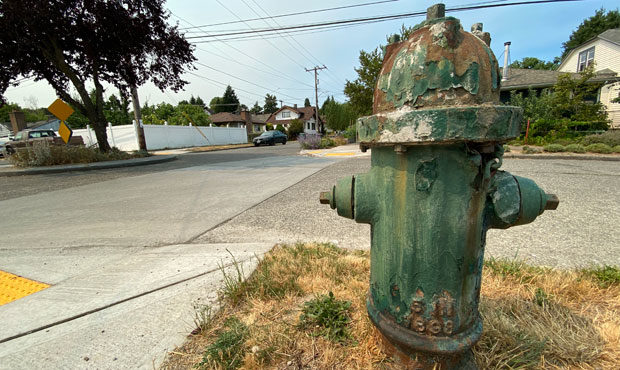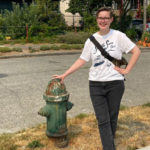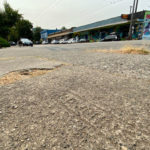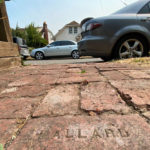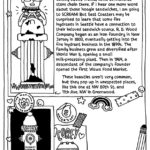‘Secret Seattle’ explores tiny pieces of the city to tell a big story
Aug 11, 2021, 10:09 AM | Updated: 11:45 am
Bricks, sidewalk stamps, old fire hydrants — most of us walk past these objects every day without pausing to take a closer look or giving them a second thought. But this might change for readers of a new book by a popular local Instagrammer that’s all about examining these smaller and often overlooked aspects of Seattle history and discovering the stories hidden within.
Secret Seattle: An Illustrated Guide to the City’s Offbeat and Overlooked History is one of the most interesting local history books to be published in the Pacific Northwest in years, and it’s likely to be a big seller for the holidays for anyone with even a passing interest in Seattle history and culture.
Author Susanna Ryan grew up in Shoreline and moved to Seattle a decade ago. Even before the pandemic, she liked to go for long walks through different neighborhoods and closely observe the city’s nooks and crannies at ground level. Ryan is also an illustrator, and in 2017, she started posting on Instagram to display her drawings of quirky things she found in Seattle neighborhoods.
Popularity of Ryan’s drawings and observations led to a book published two years ago called, like her Instagram account, Seattle Walk Report: An Illustrated Walking Tour through 23 Seattle Neighborhoods.
Like that earlier book, Secret Seattle has a certain quirkiness, but if you like noticing stuff and learning the stories behind the little things that most people overlook, the book will speak to you. You can thumb through it, skip around, and read short sections about particular things you can see – if you just take the time to look down.
For instance, if you’re ever on a stretch of sidewalk and you see barely readable letters embossed into the concrete – like Susanna Ryan did on a walk through Seattle’s Beacon Hill neighborhood a few days ago – it’s probably a “sidewalk stamp” from some long-gone construction company.
“It’s like a little business card,” Ryan said. “It’s a job well done. You know, ‘I paved this whole sidewalk, and now I’m stamping my name in it.’ So it’s just cool to see the little patchwork of cement there.”
The name in that Beacon Hill sidewalk is “N.D. Johnson.” That’s not a company Ryan is familiar with, but in the research she’s done on other names, she says most of the sidewalk stamps in Seattle date to around 1900 to 1910. Which makes sense, since that early part of the 20th century is when the residential neighborhoods in Seattle we know today were really starting to take shape.
“Some sidewalk paver a hundred years ago just dunked their [name stamper] in there and had no idea that we’d be standing here admiring it over a hundred years later,” Ryan said.
Bricks galore
A few blocks from that N.D. Johnson sidewalk stamp is a parking strip that’s been partially paved with old bricks – and many of the old bricks have the manufacturer’s name clearly visible. Ryan pointed out a brick that said “Clayburn,” which she says was made near Spokane, one that said “Denny-Renton,” and one that just said “Ballard.”
Susanna Ryan really likes old bricks.
“I could write an entire book about bricks and do all the research and stuff,” Ryan said. “It’s just amazing.”
Bricks are, literally, the building blocks of certain parts of society – buildings, streets, street gutters, chimneys, and so on. The section about bricks in Secret Seattle goes into detail about the history and the context of locally made bricks, but it’s not an almanac of esoteric facts; there are cool origin stories about the designers and manufacturers that also trace the history of the city.
For instance, that “Ballard” brick was made in factory near what’s now Carkeek Park, and the factory where the “Denny-Renton” specimens were made – in the South King County community of Taylor – could produce a quarter million bricks a day, which in 1908 was more than any other brick factory in the United States.
It’s the “nearbyness” and accessibility of this kind of hyper-observational history that really grabs Ryan’s attention and that fuels her imagination.
“The thing that really appeals to me about this is that it’s just right here on a random street,” Ryan said, admiring the number and variety of bricks in the Beacon Hill parking strip. “You know, we’re not anywhere fancy, we’re not at some tourist destination, but it’s like a tiny brick museum right here.”
“And that sort of history that you can see right before your eyes feels so much different than reading about it in a history book or having someone tell you, ‘Oh yeah, the Denny Party came and blah-blah-blah,’” Ryan continued. “It’s like it’s living and it’s here and somehow, some way, these bricks have survived all these years to end up on this random Beacon Hill street.”
“Beautiful stuff,” she added.
And the “beautiful stuff” highlighted in each section of Secret Seattle is illustrated with Susanna Ryan’s black and white line drawings – original artwork, which, it could be argued, captures this particular moment in the early 21st century better than any photographs could.
“I cannot shade for the life of me,” the self-taught artist Ryan said. “I could never draw the bowl of fruit in art class the way that they wanted me to. I’ve always just had this particular kind of style, and it’s been really refined over the years. But in some ways, I feel like it’s like the style of the ‘best 5th grader in the class’ or something.”
“It’s not quite right, but it also gets the point across well enough,” she noted.
Fire hydrants and beauty in the mundane
A few blocks east and down the hill from the inadvertent brick museum is one of Susanna Ryan’s favorite fire hydrants – yes, you read that correctly, one of her favorite fire hydrants – in the whole city.
As the vintage street survivor came into view, it was clear that even someone who considers themselves a keen observer of gritty details and bits and pieces of old infrastructure would be taken aback by this particular specimen – with its fluted sides that give it an almost neoclassical look, its chipped and peeling dark green paint, and a generous patina of rust.
“It almost feels like a caricature of a fire hydrant, or like if you looked up ‘fire hydrant’ in the dictionary, that would be the picture,” Ryan said. “It’s like your quintessential kind of fire hydrant there. I just love it.”
What sets apart Susanna Ryan’s approach to old fire hydrants – or to bricks, or whatever she examines – is her attention to details that would be mundane were it not for her curiosity, imagination, and creativity. Where most people might not even notice a particular fire hydrant, Ryan sees a whole universe of backstory, of slightly twisted humanity – and even some good old-fashioned “Seattle Process.”
“To think about how for everything you see in Seattle there was all sorts of mundane meetings and memos and people discussing the merits of like this fire hydrant over that fire hydrant, or whatever it happens to be,” Ryan said. “It’s just funny to think about. We kind of take it for granted, all these little things on our streets, and don’t really realize the bureaucratic nightmare that brought them to be.”
It’s a cliché these days to say that Seattle is changing or vanishing. It is, definitely, but that’s been true since 1851 – and thank goodness, some might say, especially those who appreciate the way Seattle seems to reinvent itself every generation or two. A city that changes dramatically – but that holds onto some core of its identity thanks to tangible aspects of its architecture and layout – is a city with a dramatic past, a dynamic present, and an unknowable and exciting future.
And that’s all good, but how would Susanna Ryan feel if she went to visit that cool old fire hydrant one day and it was gone?
“I know that nothing is forever, and I know that fire hydrants aren’t the defining thing that makes a city worth living in or whatever,” Ryan said.
But if it just disappeared, Ryan says she “would be a little bit sad at how unceremonious it was, not like I think we need to have a party to celebrate the end of the life of this fire hydrant or anything.”
“It’s just a little tiny change,” she clarified. “But the little details are so much of what make up a city and people’s experiences in their neighborhoods and stuff.”
Susanna Ryan is philosophical about Seattle and about how her book might influence those who read it, whatever their age. History, when it really connects with an audience, can provide a potent mix of information, comfort, and discomfort – but hopefully also inspiration.
“Everybody, depending on how old they are and how long they’ve been here, has a completely different idea of when that old, good Seattle was,” Ryan said. “It’s completely different for everybody. My ‘Old Seattle’ isn’t my mom’s ‘Old Seattle,’ and wasn’t her mom’s ‘Old Seattle.’”
“Cities change and things change,” Ryan said. “I think it’s up to every generation to find what they find and care about, and foster that for the next group. Time marches on.”
Georgetown exhibition, book signing details
Secret Seattle: An Illustrated Guide to the City’s Offbeat and Overlooked History by Susanna Ryan is published by Sasquatch Books and widely available from booksellers. Ryan will be signing copies of her books at an exhibition of her artwork at Fantagraphics Books in Georgetown on Saturday, Aug. 14, at 5 p.m.
You can hear Feliks every Wednesday and Friday morning on Seattle’s Morning News, read more from him here, and subscribe to The Resident Historian Podcast here. If you have a story idea, please email Feliks here.

